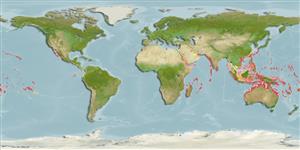>
Eupercaria/misc (Various families in series Eupercaria) >
Labridae (Wrasses) > Corinae
Etymology: Thalassoma: Greek, thalassa = the sea + Greek, soma = body; the colour of the sea (Ref. 45335).
More on authors: Lay & Bennett.
Environment: milieu / climate zone / depth range / distribution range
экология
морской ассоциированный с рифами; пределы глубины 0 - 30 m (Ref. 1602), usually 1 - 30 m (Ref. 27115). Subtropical; 24°C - 28°C (Ref. 27115); 30°N - 32°S
Indo-Pacific: Sri Lanka to Ducie Island, north to southern Japan and the Hawaiian Islands, south to southeastern Australia, Lord Howe Island, the Kermadec Islands, and Rapa. Replaced by Thalassoma grammaticum in the tropical eastern Pacific (Ref. 37816).
Size / Вес / Возраст
Maturity: Lm ? range ? - ? cm
Max length : 30.0 cm TL самец/пол неопределен; (Ref. 9710)
колючие лучи спинного плавника (общее число) : 8; членистые (мягкие) лучи спинного плавника (общее число) : 13 - 14; колючие лучи анального плавника: 3; членистые (мягкие) лучи анального плавника: 11. Body without longitudinal stripes. Initial phase body yellow with light vertical red lines. Terminal phase body abruptly blue to blue-green behind pink and green head. Reddish vertical lines on body. Pectoral fins yellow on basal half, blue to black distally (Ref 9823).
Occurs in groups (Ref. 90102) in clear outer lagoon and seaward reefs, over open sand and rubble as well as dense coral growth. Common is shallow exposed areas (Ref. 9710). Benthopelagic (Ref. 58302). Feeds mainly on shelled benthic invertebrates (crabs, shrimps, gastropods, bivalves, brittle stars, sea urchins), also on polychaete worms and fish eggs. Minimum depth reported taken from Ref. 128797.
Life cycle and mating behavior
половая зрелость | размножение | нерест | икра | Fecundity | личинки
Pelagic spawner.
Randall, J.E., G.R. Allen and R.C. Steene, 1990. Fishes of the Great Barrier Reef and Coral Sea. University of Hawaii Press, Honolulu, Hawaii. 506 p. (Ref. 2334)
Статус Красного Списка МСОП (Ref. 130435: Version 2024-1)
Угроза для людей
Harmless
Использование человеком
рыболовство: не имеет хозяйственного значения; аквариум: коммерческий
дополнительная информация
инструменты
Специальные отчеты
Скачать в формате XML
ресурсы в Интернет
Estimates based on models
Preferred temperature (Ref.
123201): 24.3 - 28.9, mean 27.5 °C (based on 1148 cells).
Phylogenetic diversity index (Ref.
82804): PD
50 = 0.5000 [Uniqueness, from 0.5 = low to 2.0 = high].
Bayesian length-weight: a=0.01000 (0.00611 - 0.01635), b=3.05 (2.91 - 3.19), in cm total length, based on LWR estimates for this species & Genus-body shape (Ref.
93245).
Trophic level (Ref.
69278): 3.7 ±0.4 se; based on diet studies.
устойчивость к внешним воздействиям (Ref.
120179): средний (среднего размера), минимальное время удвоения популяции 1.4-4.4 года (Preliminary K or Fecundity.).
Fishing Vulnerability (Ref.
59153): Low vulnerability (20 of 100).
Nutrients (Ref.
124155): Calcium = 34 [16, 74] mg/100g; Iron = 0.585 [0.320, 1.149] mg/100g; Protein = 19.4 [16.5, 21.6] %; Omega3 = 0.217 [0.125, 0.383] g/100g; Selenium = 12.2 [6.0, 24.1] μg/100g; VitaminA = 72.2 [21.6, 300.0] μg/100g; Zinc = 0.907 [0.578, 1.527] mg/100g (wet weight);
